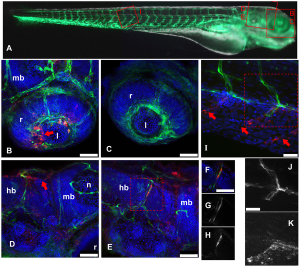But of course, this in vivo stuff is a great deal more difficult than in vitro studies and appropriate animal models don't just grow on trees; this is why, when a relevant model system of viral infection comes along we get excited - well at least I get excited. Unless you look at everything in its entirety, you never know what you will miss and viruses being as small as they are, its easy to miss something important and missing something important is bad news in the world of science.
A recently published study has looked at viral infection at the 'global' or whole-organism level using transgenic zebrafish larva infected with Infectious Hematopoietic Necrosis Virus (IHNV), an RNA virus related to rabies virus and is particularly deadly if you happen to some form of salmonid. Zebrafish are generally pretty good models for a whole lot of biological processes: zebrafish genetics are pretty well understood allowing for easy transgenics; they are particulary easy to study, especially to image as they are small and transparant and some genes/pathways are well conserved with humans meaning that it may have some applications to us. These factors all suggest that zebrafish may be a pretty decent model to understand viral infection in general, not just in fish.
Following infection, they were able to look at entire whole organisms for viral presence, concentrating on what particular cells/organs contain viral mRNA and proteins. They were able to follow infection through its entirety, at early stages and the later stages when serious disease takes hold, allowing the elucidation of intra-host viral spread and dissemination. They used their system to shed light on the mechanisms of IHNV pathogenesis, showing that viral infection led to vascular endothelium destruction and impaired blood flow. It is just near impossible or at least a lot of hard work to do this kind of analysis in any other model system.
[caption id="attachment_161" align="aligncenter" width="300" caption="Zebrafish viral infection: In blue are cell nuclei, green endothelial cells and red viral proteins."]
 [/caption]
[/caption]Using this model - as in all model systems - comes with certain caveats attached: IHNV is not a natural pathogen of zebrafish (indeed, to date no viruses have been described) , i.e. what we see here may not be exactly what happens out there in the real world when this virus infects salmon. The virus was also injected into the bloodstream of these fish which is highly unlikely to occur in the wild - how would the infection change if it were administered another way? Not considering these issues, this work offers up a decent picture of systemic dissemination of IHNV in a not-so-perfectly matched host. Only time will tell how applicable to the real-world this is.
Its hard to imagine this work being carried out in any other kind of vertebrate - transparent rats in the future perhaps? But this stuff has been carried out using GFP expressing viruses within a non-human primate model only a week before this. Although not as easy to image, hard-work and dedicatedly searching through cells and tissues for signs of infection allows us to understand viral infection at the whole-organism level more appropriate to human disease.
This pretty much makes their statement below a bit incorrect, or at least out-dated:
We describe in this paper the spread of a viral infection throughout an entire organism, something that, to our knowledge, has not been done before in a vertebrate.
As a final thought, wouldn't it be great to image viral infection in real-time using a GFP-expressing IHNV in this zebrafish model? - just checked, there is a GFP IHNV virus out there. Check out the live-cell imaging of GFP neutrophils in a zebrafish above.

- Two Zebrafish larvae
Ludwig, M., Palha, N., Torhy, C., Briolat, V., Colucci-Guyon, E., Brémont, M., Herbomel, P., Boudinot, P., & Levraud, J. (2011). Whole-Body Analysis of a Viral Infection: Vascular Endothelium is a Primary Target of Infectious Hematopoietic Necrosis Virus in Zebrafish Larvae PLoS Pathogens, 7 (2) DOI: 10.1371/journal.ppat.1001269

















No comments:
Post a Comment
Markup Key:
- <b>bold</b> = bold
- <i>italic</i> = italic
- <a href="http://www.fieldofscience.com/">FoS</a> = FoS